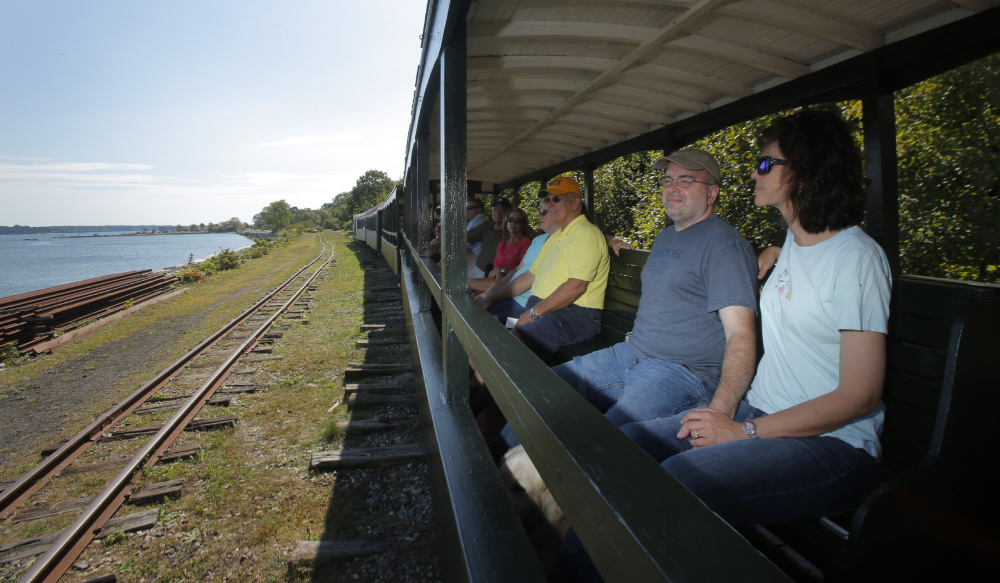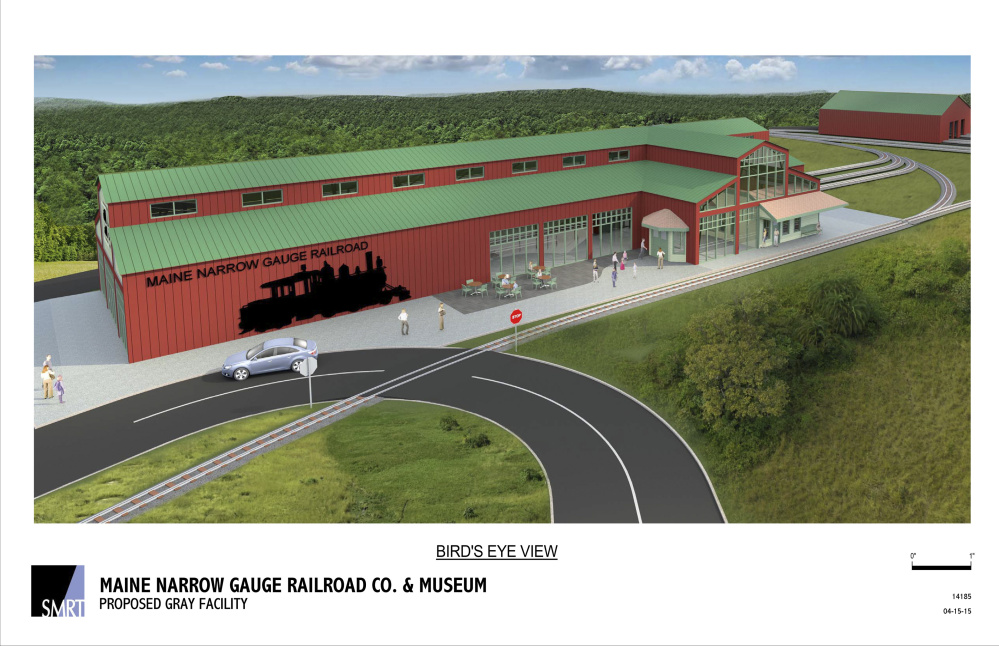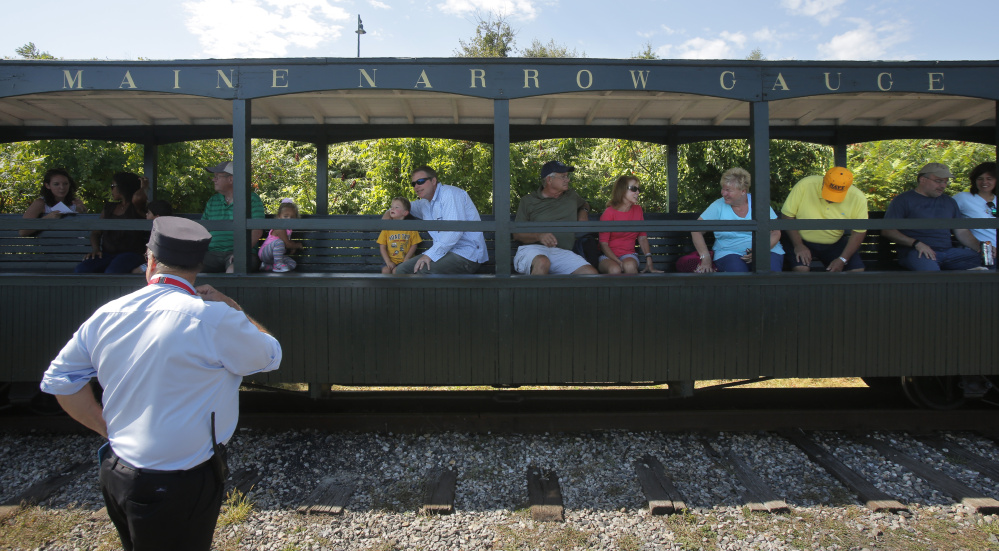As the train moved out of the station last week at the Maine Narrow Gauge Railroad, 3-year-old Riley Porter smiled and sat tall on his dad’s lap.
Henry and Riley Porter, who live in Cumberland, are regular passengers on the historic trains and hope to continue riding the 2-foot-wide rails when the attraction moves from the Portland waterfront to a new home in Gray. But Porter is among those worried about money to pay for the relocation, which is set to take place in 2018.
“I’m concerned they’re not funded enough to make it happen,” he said.
The town of Gray is facing a decision about whether to bring new life to the Maine Narrow Gauge Railroad Co. & Museum’s plan or add a significant hurdle to its fundraising effort. On their ballots in November, residents could be asked to give nearly $500,000 to the railroad.
If the measure is approved, Gray officials would likely dip into cash reserves in the name of economic development. If it’s defeated, the museum’s six years of effort to move to Gray could lose steam.
“The springboard really becomes this grant that the town is looking at for us,” said Donnell Carroll, executive director of the museum. “That clearly adds legs and credibility to the project.”
The Town Council will vote Tuesday night on whether to send the question to a referendum.
The nonprofit originally promised that taxpayers would not bear any costs to relocate the museum, but now argues that the town contribution would attract private donors who have been wary thus far. Gray residents who know about the possible grant have mixed feelings about such a gift.
The Maine Narrow Gauge Railroad runs a historic passenger train on 1.5 miles of track on Portland’s eastern waterfront from May to October, as well as the popular Polar Express ride around Christmastime.
The museum currently leases a 7,500-square-foot space in the Portland Co. complex on Fore Street, but the landowners plan to eventually redevelop the site with a new marina and a mixture of historic, commercial and residential buildings. The board began looking for its own property in 2009 and announced Gray as its destination in 2011. The website describes the new location as a 13,500-square-foot museum, plus a 5,000-square-foot engine house and restoration shop, a 12,500-square-foot car barn and over 3 miles of track.
SPEEDING UP A SLOW PROCESS
Carroll estimated the new location on Route 100 will cost between $4 million and $6 million. The museum’s lease on the water expires next year, but so far, the nonprofit has raised less than $500,000 in funds and in-kind contributions.
“We can feel people getting more open to discussions,” Carroll said. “This (grant from Gray) definitely would be the seed money that we could say, ‘Would you be now willing to … match the town of Gray?’ ”
In a 2014 letter to the Portland Press Herald, Carroll said he did not plan to ask the town for money to help the cause. “The estimated costs will be raised through fundraising and grant writing – not on the backs of taxpayers,” he wrote.
Jason Wilson, the funeral director at Wilson Funeral Home in Gray, joined the Town Council this summer. Discouraged by the slow pace of the museum’s move, Wilson suggested a public-private partnership between the town and the railroad. Town officials, the museum and a team of lawyers discussed their options, and they recently proposed a $498,000 grant from Gray to cover startup costs such as land acquisition, design work and permitting fees.
Wilson said the museum’s new location could benefit the whole town by growing the tax base and attracting new businesses.
“It’s an investment for Gray,” he said. “There’s not a special-interest investment like an intersection or a sidewalk. It will help fund all those infrastructure projects for all of Gray in the future.”
Town Manager Deborah Cabana said the money would likely come from Gray’s unassigned fund balance, which the town estimates is about $768,000 over its target amount. If the money does come from those cash reserves, the railroad grant would not have a direct impact on the property tax rate. Gray’s mill rate is $18.05 per $1,000 of assessed property value.
In the current tax year, Cabana said the grant would have added 65 to 70 cents per $1,000 of assessed value to that rate, or an extra $65 to $70 on the tax bill for a $100,000 home. The town’s spending this year is about $7 million, so $500,000 represents about 7 percent of that figure.
“The council is feeling that partnering with the Maine Narrow Gauge is investing in potential economic development that will occur as a result of having the narrow gauge in our community,” Cabana said. “Other businesses will benefit from it. People that come to visit the narrow gauge will come visit our other restaurants and businesses in town.”
VIEWS OF CUSTOMERS, TAXPAYERS
Among the area’s other attractions are the Maine Wildlife Park, the Spring Meadows Golf Club, Little Sebago Lake, antique shops and Pineland Farms in New Gloucester. An economic impact study conducted by the museum estimated visitors would bring $1.2 million annually to other businesses in Gray.
“I think this could be the biggest economic catalyst in 35 years to come to Gray,” said Carroll, who also lives in the town.
At its current home on the Portland waterfront, the museum pulls in more than 30,000 visitors a year.
Chrissy Buotte, 28, of Old Orchard Beach, rode the train Wednesday with her two young children and her father. They visit the museum a couple of times a year, and Buotte said she would still make the trip if the trains were in Gray. Her 1-year-old daughter, Ava, clapped as the ride ended.
“All done,” she announced.
In addition to offering rides in Gray, the group hopes to continue operating a train in Portland until 2023, when its lease with the state to use the rail line expires. Without the waterfront views, however, some are skeptical about its success in the new location 18 miles inland.
Carrying groceries at the neighboring Gray Plaza, Janet Remington said she has taken her 2-year-old grandson to ride the narrow gauge train in Portland and would visit the attraction in Gray. Her in-laws live in the town, she said, but she hasn’t heard them express concern about the possible grant to the museum.
“It’d be a smart idea,” Remington said.
Robert and Cora Skilling, longtime residents of Gray, hoped for a wealthy benefactor to make a large donation to the museum.
“I don’t know if we can afford it,” Robert Skilling said of the town grant. “It’d be nice to have.”
“It’s the taxpayers’ money,” Cora Skilling said. “That’s what hurts.”
Another Gray resident, William Keith, voiced concern in a letter to the editor about the railroad’s move as early as 2014.
“I don’t mind them coming to town,” he said Wednesday. “But now they want a half a million of taxpayers’ money. It’s not a loan. I just don’t think it’s fair.”
His wife, Mary Keith, noted the town is undergoing its first revaluation since 2003, so property values and tax bills are likely to go up for some residents.
“Instead of spending the money for (the museum), they should be holding onto it to alleviate the tax burden,” she said.
MOVE STILL ON IF GRANT DEFEATED
Should Gray residents turn down the grant, the nonprofit would still pursue its move to the town.
But it would be “a major setback,” Carroll said, likely requiring the museum to significantly scale back its plans.
“If you’re talking to private funders and grant writers, and a local community that you’re moving to offers a public-private partnership, and the voters turn it down, it’s going to raise some eyebrows,” Carroll said.
The meeting is scheduled for 7 p.m. Tuesday at the Henry Pennell Municipal Complex at 24 Main St. in Gray.
Send questions/comments to the editors.






Success. Please wait for the page to reload. If the page does not reload within 5 seconds, please refresh the page.
Enter your email and password to access comments.
Hi, to comment on stories you must . This profile is in addition to your subscription and website login.
Already have a commenting profile? .
Invalid username/password.
Please check your email to confirm and complete your registration.
Only subscribers are eligible to post comments. Please subscribe or login first for digital access. Here’s why.
Use the form below to reset your password. When you've submitted your account email, we will send an email with a reset code.